Call the Midwives
How midwives in Washington are caring for mothers while challenging their past — and future
By Julia Furukawa
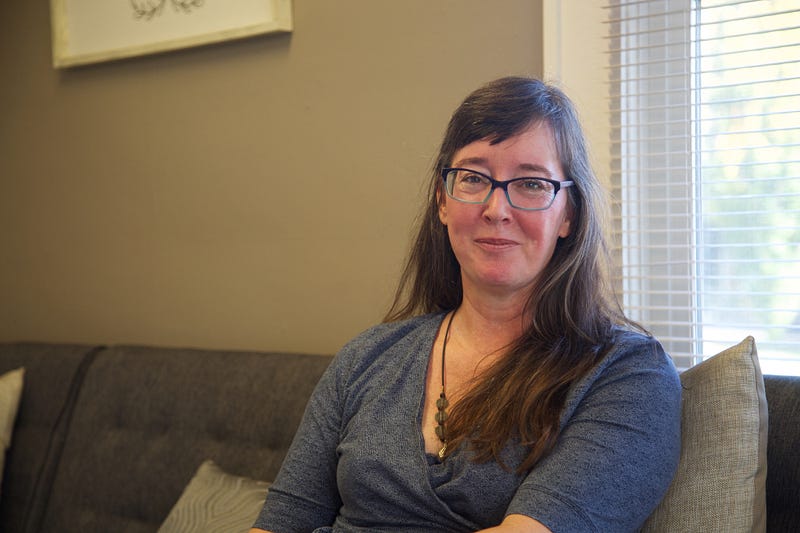
Walking into Mary Burgess’ midwifery clinic is like entering a safe and sacred space. Her practice, Moonbelly Midwifery, is nestled on a corner in the sleepy city of Lynden, Washington.
Warm sunlight streams through the windows of the waiting room, photos of newborns adorn the walls and an inviting couch offers a comfortable perch for expectant mothers awaiting their appointments.
The building, aptly named “The Nest,” houses Burgess’ midwifery practice and two other practitioners.
Burgess’ luminous blue eyes twinkle as she looks over photos of past clients with their babies laid out on the glass table in her waiting room. Burgess was called to midwifery after wearing many hats — an audiologist, a doula and a childbirth educator. She took a leap and left home to attend the Midwives College of Utah. Now she’s one of the many midwives in Washington that delivers around 13% of newborns in the state.
Burgess points at one of the photos. It’s a giggling baby boy with rosy cheeks, snuggled between two adoring parents. A smile breaks out across her face.
“Isn’t he precious?,” she said.
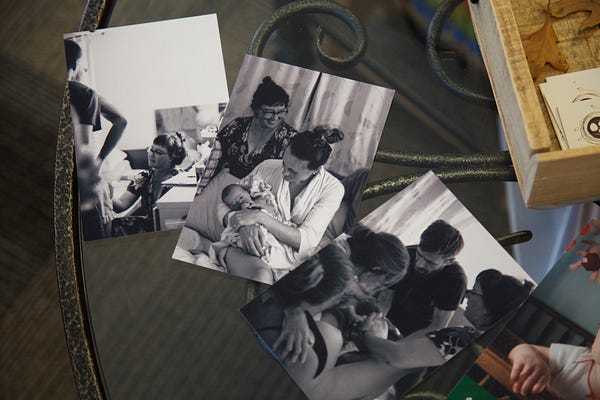
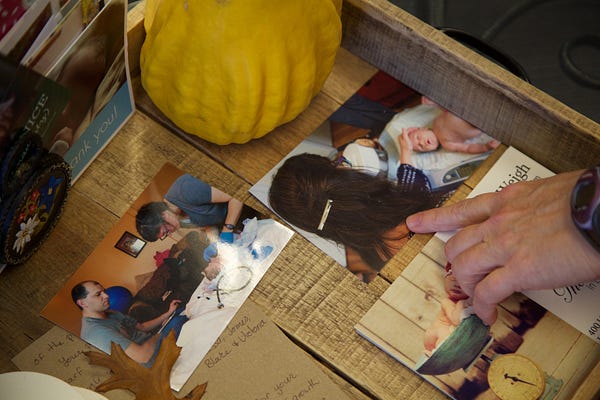
A CHECKERED PAST, A BIASED PRESENT
In 2012, more than 98% of newborns in the U.S. were delivered in hospitals, and only 7.6% of births were attended by a midwife, according to the Centers for Disease Control and Prevention. These statistics looked far different a hundred years ago.
Before the late 1800s, the vast majority of deliveries were performed at home by a midwife. The push toward hospital births and away from midwifery can be traced back to the emergence of medical schools and physicians.
As a result of a concerted campaign to push midwives out of the maternity care realm, women increasingly turned to hospitals and physicians for their deliveries. According to Beth Arcese, a licensed midwife practicing in Bellingham, even more than 100 years later midwives and OB-GYNs still butt heads over whose practice is more legitimate. But steps are being taken to repair some of those divides.
Arcese is on a mission to repair the often adversarial relationship between midwives and doctors. Arcese is part of a statewide workgroup, Smooth Transitions, that aims to build relationships between OB-GYNs, nurse midwives and privately practicing midwives.
Arcese collaborates with doctors at the local hospital, PeaceHealth St. Joseph Medical Center, to better understand how maternity care providers can work together to serve their patients and how their different practices can exist in harmony.
“[Midwives] are hearing things that we never have thought about from [the doctors’] perspective and they’re understanding more about our perspective,” she said. “It’s progress.”
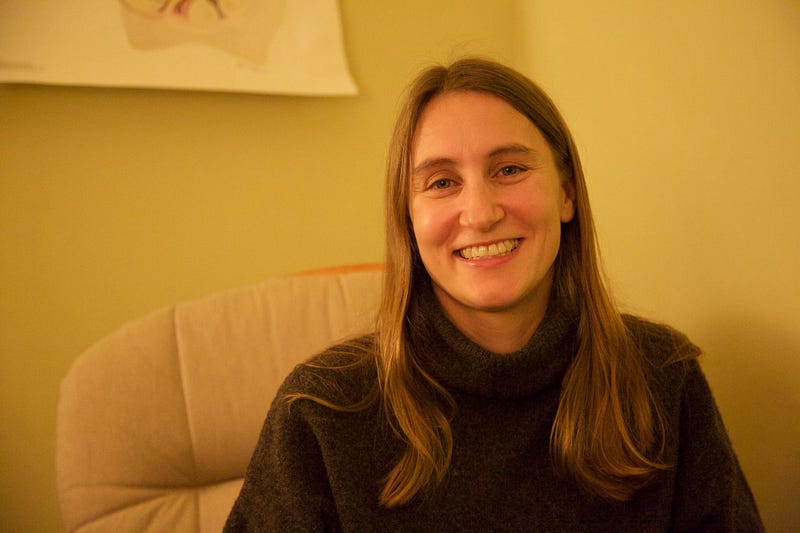
For Arcese, progress is all about ensuring the best outcomes in maternity care, regardless of how a mother decides to deliver.
“Let’s collaborate and make it the safest that it can be for the people in our community,” she said.
For Wendy Gordon, a licensed midwife and professor of midwifery at Bastyr University, another key issue in the midwifery community is the lack of diversity based on race, class, sexual orientation and ethnic background. She attributes this to the renaissance of “modern” midwifery; a resurgence of the practice in the 1960s.
“MODERN” MIDWIFERY: Diagnosing Problems, Prescribing Solutions
The 1960s and 1970s were a time of empowerment for women. The Second-Wave Feminism movement arose as women demanded equal pay, life away from the house, an end to employment discrimination and autonomy over their own bodies. Along with that came the resurgence of midwifery. Second-Wave Feminism, however, was an overwhelmingly white movement that largely excluded queer women, transgender women and women of color.
“Modern midwifery, as of the mid-70s or so, is a very white profession,” Gordon said. “And that’s precisely because [modern] midwifery kind of arose on the backs of the Second-Wave Feminists.”
Scholar Ruth Frankenberg, author of White Women, Race Matters: The Social Construction of Whiteness, noted how the movement gave a new voice to white women while simultaneously silencing the voices of women of color.
That lack of space for people of color made its way from marches in the streets to midwifery. A 2014 study found that less than 10% of midwives in the U.S. are people of color. For Gordon, creating a space for people of color needs to start early on in one’s midwifery journey: in the classroom. Gordon teaches at Bastyr University, formerly known as the Seattle Midwifery School, and specializes in studying racial disparities in midwifery care.
Gordon said the whiteness of midwifery is intertwined with the disenfranchisement of midwives from the medical community. For many years, it was common for insurance companies to not cover midwives as care providers so the only people who could access their care were predominantly wealthy white women. Gordon said the lack of diversity in the field then became a cyclical problem: Women who decided to go into midwifery were largely women who’d delivered with a midwife and then realized that was the career they wanted to pursue.
Gordon believes midwifery care is a healthy alternative to the current system of maternity care in the U.S., but there are barriers that need to be overcome — educational, legal and otherwise — before midwives can make up a larger fraction of maternity care.
“Our current maternity care system is not working,” Gordon said. “As much money as we spend on maternity care and childbirth in the United States, we do not have the best outcomes [because] the care that is provided is fractured.”

Midwifery students who graduate from Bastyr University have fulfilled all necessary requirements to legally practice midwifery in Washington state, but for Gordon, simply meeting the technical requirements to become a midwife doesn’t repair all those fractures. Gordon helped develop a course, mandatory for all students entering the midwifery school at Bastyr, that addresses racial disparities in midwifery and healthcare as a whole.
“It’s kind of ‘Racism 101’ — ‘Racism and Whiteness 101’ — [to help students] understand and build a vocabulary and sort of an analysis of the issues that we as a society are dealing with,” Gordon said. “Because it’s everybody’s problem, this isn’t just a problem for people of color.”
The class is particularly vital because of the real, lived consequences of subpar medical and maternity care for women of color. Gordon noted that women of color, particularly black and Indigeous women, are subjected to structural racism within the healthcare system meaning societal racism permeates the care they receive.
For example, Gordon said if a white woman and a woman of color presented the same concerns about their health, it’s far more likely that the white woman would be offered a suite of options to address them, like lab work, a consultation with a specialist or an MRI.
Structural racism rears its head in maternity care and birth outcomes as well. According to the CDC, black women die from preventable pregnancy-related complications at three-to-four times the rate of white women, preterm births are more common for them, and their newborns have statistically lower birth weights and higher mortality rates than white babies.
While Gordon knew the troubling statistics, she didn’t just think of instituting the class as a requirement without prompting. She said she witnessed firsthand the real impact of the unfair treatment of midwives and mothers of color in 2012. That was the year a group of midwives of color made the decision to leave the Midwifery Alliance of North America.
“That particular moment when they just left and said ‘We’re done. We’re done with you,’ that definitely precipitated my wake-up call and helped me to finally see what was going on,” Gordon said. “They made me think.”
PARA LA MADRE
At her Lynden practice, Burgess is working to break some of the barriers women of color face. On her left arm, tattooed in crisp black ink over a blue crescent moon, are the words “Para La Madre,” or “for the mother,” in Spanish. As a white, native English speaker, Burgess knew she wanted to take steps to make her care as a midwife more accessible.
Over the past several years, she has been learning Spanish so she can provide maternity care for women who may not speak English or for whom Spanish is their preferred language. In Lynden, Hispanic or Latinx people are the largest non-white ethnic group group, making up more than 7% of the population. Reaching out to the Spanish-speaking community in their language is particularly important for Burgess.
“It became really important to me to improve my Spanish,” Burgess said. “So well, I’m not fluent yet, but I spend a ton of time trying to learn more… ”
For her, learning more also means learning more about the culture of the Latinx women she cares for. Her office is decorated with vibrant paintings of indigenous Mexican women. An ornate religious candle, or veladora, depicting La Virgen de Guadalupe, known in English as the Virgin Mary, sits on her desk. Her educational materials, like fetal diagrams and informational pamphlets, are written in both English and Spanish.
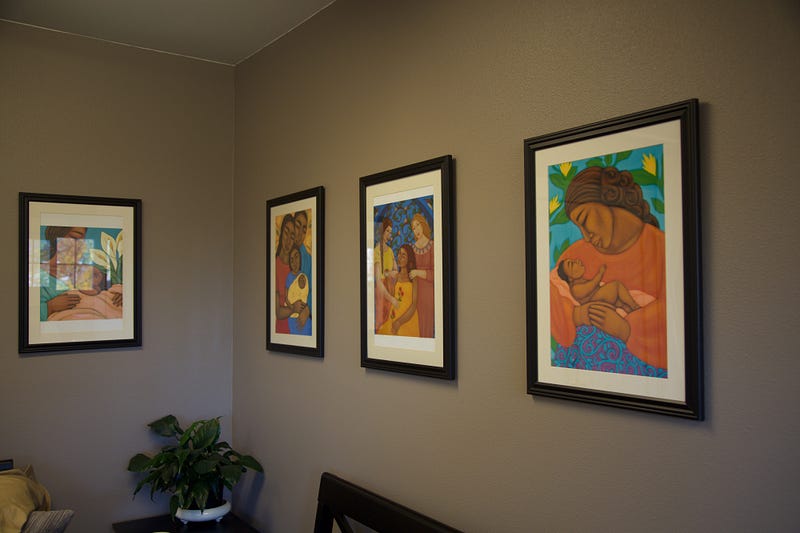
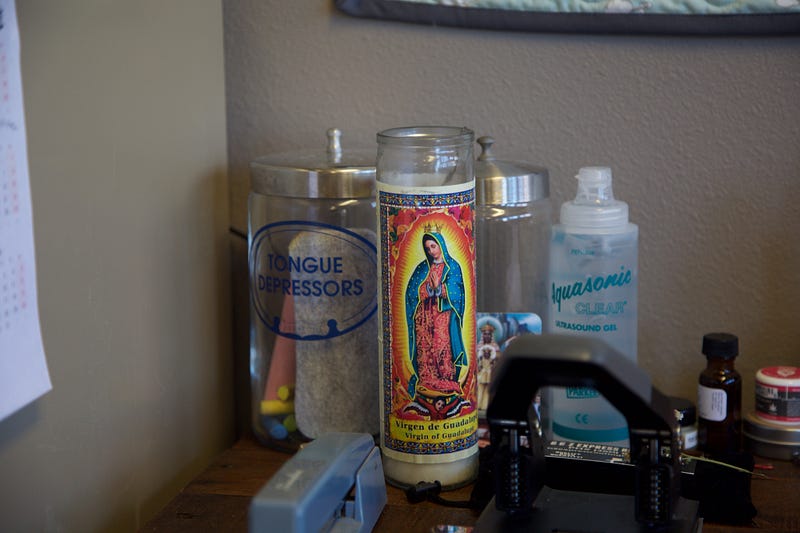
Burgess also incorporates traditional Mexican midwifery knowledge into her practice, like using a rebozo and a woven shawl with some of her patients. The soft, colorful shawl can be used for anything from carrying a baby, to pain relief during labor, to repositioning a fetus in the womb for an easier labor.
Outside of her practice, she’s also involved in local groups that advocate for better health care for women of color, like the Whatcom County branch of the Perinatal Mental Health Task Force and the Immigrant Families Health Task Force. Her involvement in those groups keeps her growth-mindset alive.
“I’m just learning to learn more and find out what’s going on [in the community],” Burgess said. “Where are the holes? What are the possibilities what can midwives offer? What can I offer what’s needed?”
What Burgess does offer is financially accessible care. She accepts Washington state’s Medicaid insurance, Apple Health, so mothers of all income levels can choose care from her. This includes regular prenatal check-ins, ultrasounds and lab work, deliveries, and two weeks of postpartum care for the baby and six for the mother. Burgess estimates that roughly 90% of her patients use Apple Health to pay for her services. She said it’s important that her whole spectrum of care is accessible for patients because she views maternity care from a holistic perspective.
Burgess meets with her patients every four weeks at the beginning of their pregnancies and every two weeks toward the end. She asks for information about all facets of their lives, from diet and exercise to home life, work, and medical and emotional history.
She said this holistic approach is vital when working with clients who’ve experienced trauma, because women often hold trauma in their pelvis and it can make childbirth excruciating; even more so if their provider is unaware of their history.
“She holds it very, very much inside and labor is the time where everything opens up,” Burgess said. “A woman who’s been raped or who’s experienced sexual assault of any kind — even if she doesn’t remember it — her body remembers it and so you see it in labor and it can be incredibly challenging.”
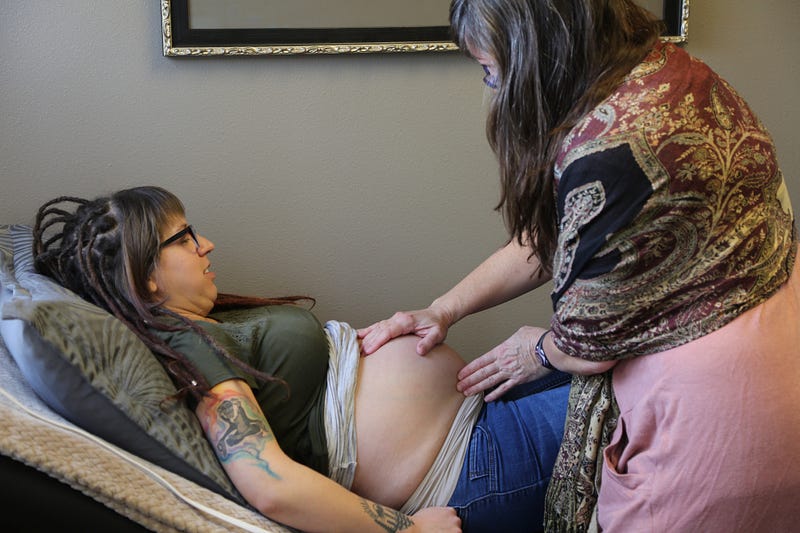
The chance to build a deep connection with her patients is one of the aspects Burgess enjoys most about her work as a midwife.
The individualized relationships Burgess gets to build with her patients mean stronger, longer bonds. Some mothers return to her clinic for help with breastfeeding. Some come in on Thursdays when Burgess offers free baby weighings. Others send her photos, cards and updates about their little one.
She attributes the fortitude of those relationships to the nature of midwifery. As a midwife, instead of viewing childbirth as potentially catastrophic medical event, she sees it an awe-inspiring natural phenomenon.
“The difference is the lens of midwifery care is more like: Birth is an extraordinary event in a woman’s life,” Burgess said. “It just requires…a lot of support so she can become the confident, strong mama bear that she needs to be and that her baby needs her to be.”
